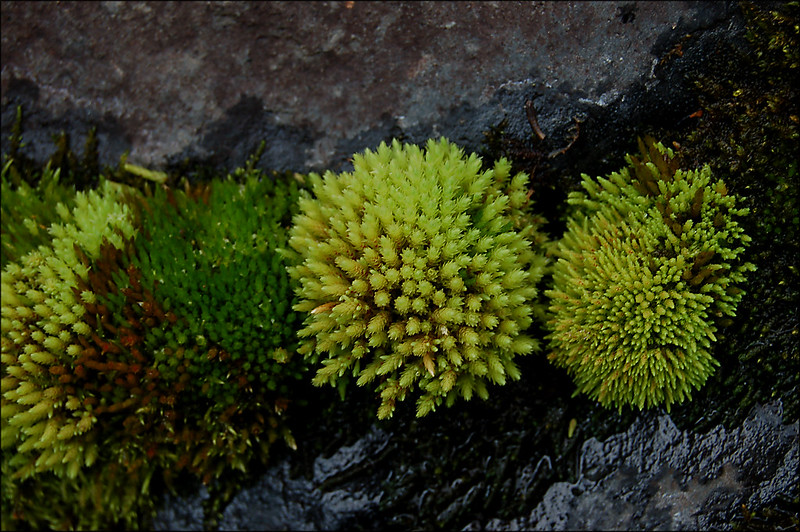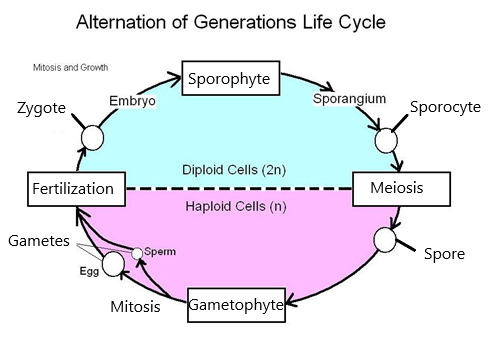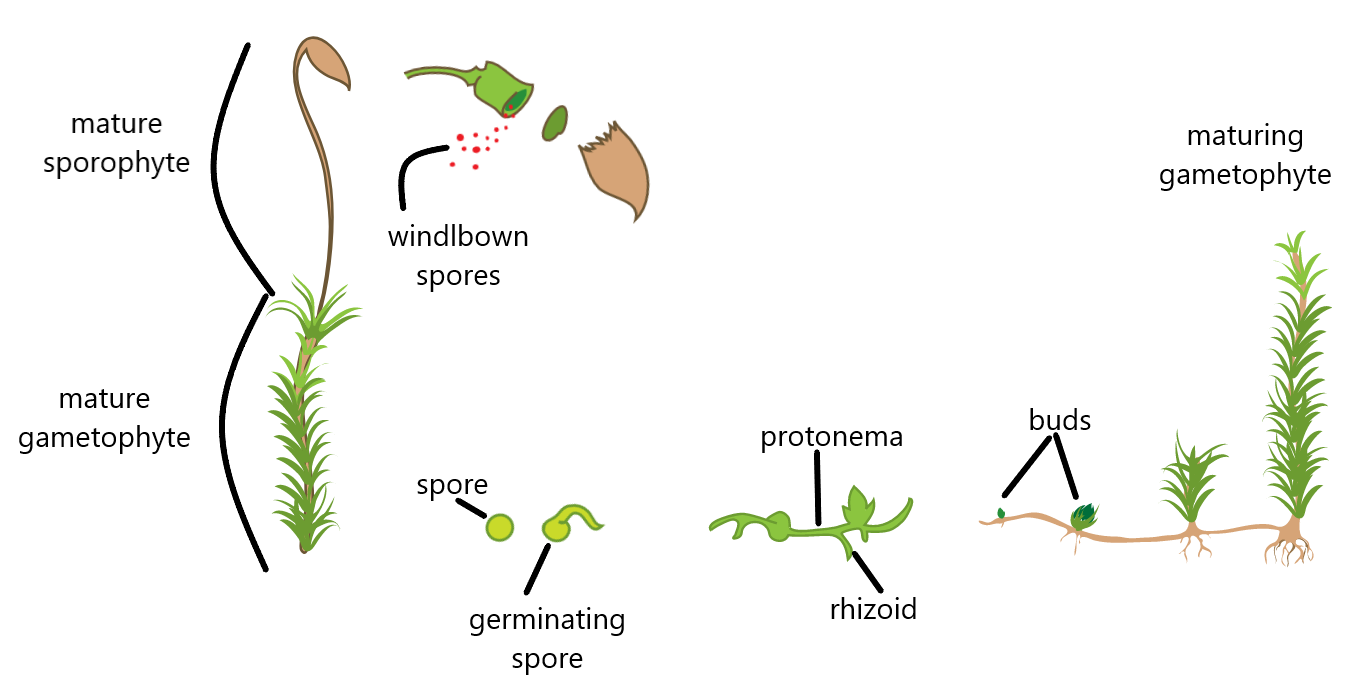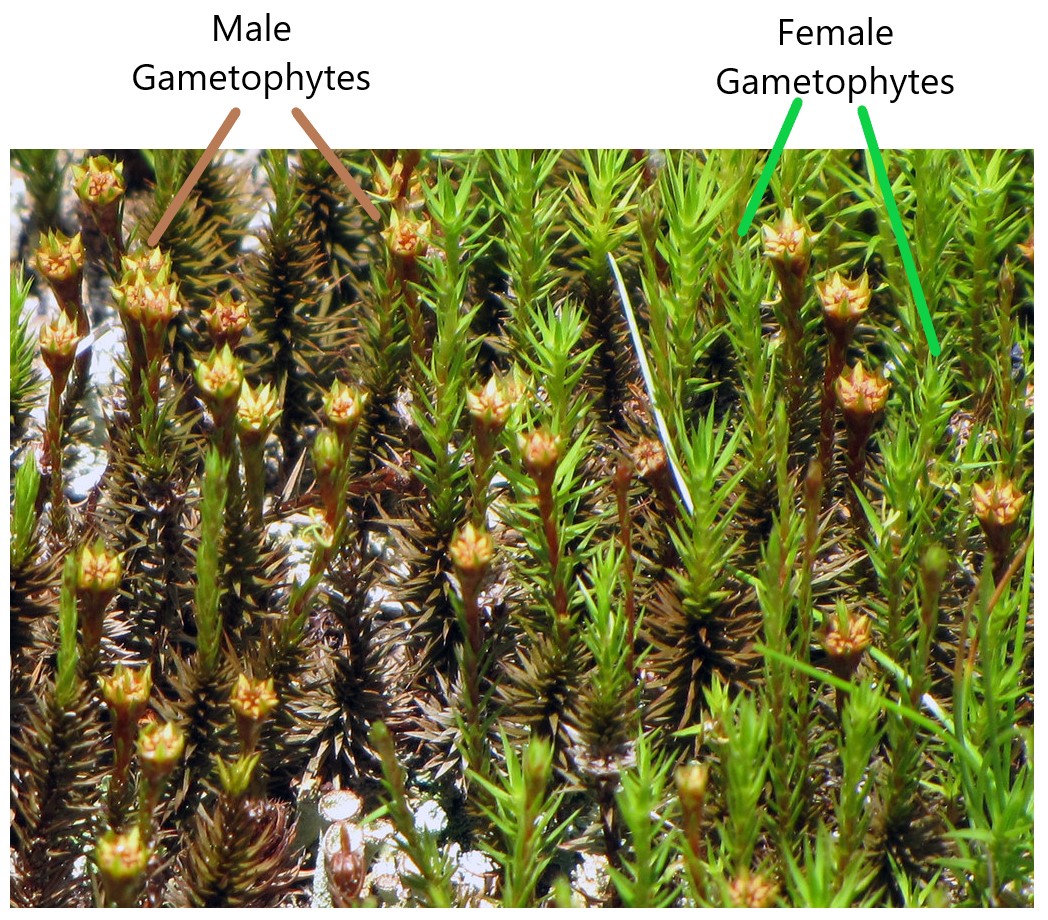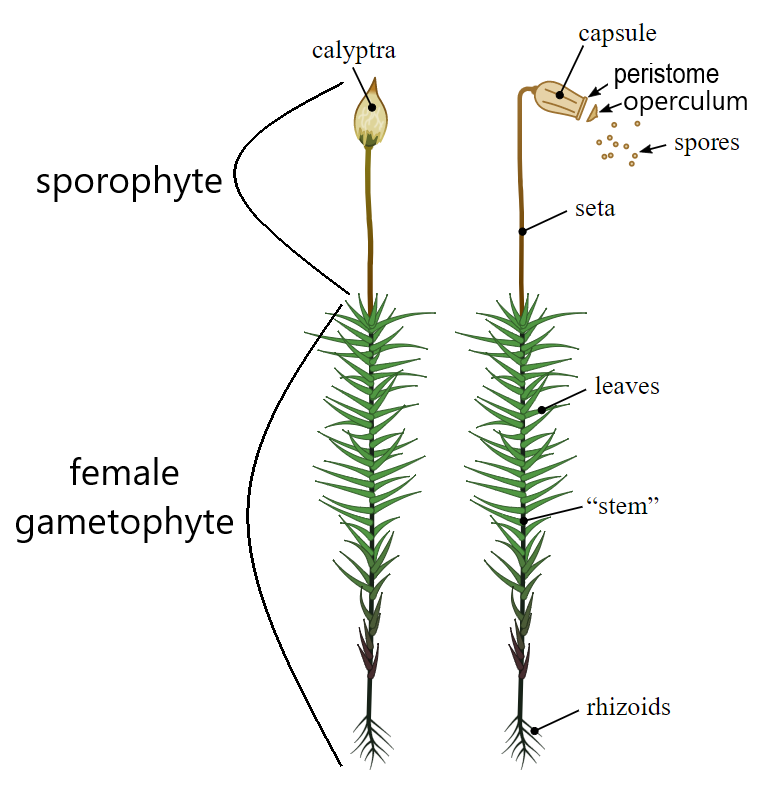Lab Content: The Life Cycle of Mosses
The Primitive Nonvascular Plants – Bryophytes
Bryophytes, more commonly known as mosses, are some of the smallest members of the plant kingdom. These tiny plants are commonly found in damp, shady places across the globe. Part of their success lies in the ability to spread via windborne spores. There are around 11,000 species of mosses.
In this lab, we will consider mosses and their life cycles.
Image Licenses and Attributions: Title: Moss Diversity; Author: Tony Frates; Source:https://www.flickr.com/photos/tonyfrates/7982931814/; License: Standard License
Mosses are among the simplest of the true plants. They belong to the Phylum Bryophyta. Plants evolved from algae and still share several characteristics with algae. Both plants and the algae they evolved from have:
- Photosynthetic pigments. This always includes Chlorophyll a, but also often includes Chlorophyll b and the accessory photosynthetic pigments referred to as carotenoids.
- Store sugars in their cells as starch. (You might recall that simple sugars will crystallize and pop cells. To solve this, plants and algae store long chains of simple sugars in the form of starches.)
- Cellulose makes their cells at least semi-rigid.
- Cytokinesis requires a new cell wall to be grown between what will be two daughter cells.
Mosses are more complex than algae which have resulted in them being placed in Kingdom Plantae. Members of the plant kingdom share some common traits that are found in mosses:
- Multicellular gametangia are structures used by plants to make gametes.
- Eggs are fertilized by sperm, resulting in a zygote that grows into a multicellular embryo. If successful, the embryo will grow into the diploid sporophyte. In the higher plants, the sporophyte generation is dominant.
- Specialized tissues for photosynthesis, storage, conduction, etc.
- Usually, plants primarily rely upon sexual reproduction resulting in variation among their offspring.
However, mosses are among the most primitive of the true plants because they are lacking some features found in higher plants. Mosses do not have the following:
- The vascular tissues are phloem and xylem. In higher plants, phloem carries carbohydrates (typically produced in the leaves) to the rest of the plant tissues. Xylem carries water, absorbed by the roots, to the rest of the plant. Because mosses are lacking these tissues, they are quite tiny.
- In higher plants, the sporophyte generation is dominant. In mosses, the gametophyte generation is dominant.
Fertilization and the Alternation of Generations Life Cycle in Plants
In animals, sexual reproduction is accomplished through the union of gametes to form a zygote. In plants, the process is more complicated with two possible organisms formed, the sporophyte and the gametophyte. (Recall that the suffix "phyte" just means plant.)
- The sporophyte generation is the diploid generation in plants. It is the dominant generation in the higher plants. The dominant generation is simply the generation of the plant that is largest and longest lasting. Sporophyte means "spore-making plant." The sporophyte produces haploid spores via meiosis.
- Haploid spores germinate and grow into the haploid gametophyte generation. Gametophyte refers to the "gamete-making plant." This generation produces the gametes (egg and sperm) by mitosis.
Image by S. Estlack.
The Life Cycle of Mosses
A moss begins its life as a haploid spore shaken from a capsule by the wind. Most spores do not succeed, but some will land where there is enough light, soil, and water available to germinate.
Image modified by S. Estlack. Source Image Licenses and Attributions: Title: Lifecyle moss svg diagram; Author: LadyofHats; Source: https://commons.wikimedia.org/w/index.php?title=File:Asexual_reproduction_moss_svg_diagram_nolabels.svg&oldid=456924256; License: Standard License
In the photo below are moss spores viewed under a microscope.
Haploid moss spores will germinate and grow into protonema. The protonema is a tiny, branched, filamentous structure that will produce multiple buds. Each bud will grow into a separate gametophyte.
In the photo below are protonema viewed under a microscope.

The protonema produces multiple haploid buds. These buds will grow into separate male and female gametophytes. The male gametophytes will have a flattened, cup-like top while the female gametophytes appear pointed at the top.
Image modified by S. Estlack. Source Image Licenses and Attributions: Title: Polytrichum Gametophytes; Author: BlueRidgeKitties; Source: https://www.flickr.com/photos/blueridgekitties/4717766223; License: Standard License
Antheridia (the male gametangia) are produced at the top of the male gametophytes. Inside each antheridium, a mass of tissue will develop into numerous coiled or comma-shaped sperm cells.
Archegonia (the female gametangia) are produced at the top of female gametophytes. Archegonia produce a single egg in a cavity known as the venter. A neck, containing a narrow canal, extends above the venter. Several archegonia are typically produced at the top of the female gametophyte.
Both antheridia and archegonia are surrounded by sterile, hair-like filaments called paraphyses.
Strangely enough, the moss gametophytes are now entirely dependent upon a rain shower for fertilization to take place. Water collects and is held at the top of the gametophytes by the paraphyses. The antheridia absorb this water and swell, releasing their sperm. Each sperm is propelled forward by a pair of flagella. The hope is that the sperm will be splashed by raindrops onto the tops of neighboring female gametophytes. The archegonia release sugars, proteins, acids, or other substances that attract the sperm. Sperm will swim down the neck of the archegonium, fertilizing the egg, to form a diploid zygote. This zygote rapidly grows into a spindle-shaped embryo.
Illustrated life cycle of Polytrichum sp. 1) the sporophyte 2) the spores 3) the spores germinate into a protonema 4) antheridia 5) archegonia 6) fertilization
The embryo breaks down the cells at the base of the archegonium and develops a swollen knob, or foot, by which it firmly attaches to the gametophyte stem. The rapidly growing embryo soon splits the top of the venter off. The top of the venter, which resembles a pixie cap, is now referred to as the calyptra.
The maturing sporophyte is green and photosynthetic but still relies upon the gametophyte for at least some of its carbohydrate, water, and mineral needs. Mature sporophytes consist of a capsule located at the tip of a slender stalk called the seta. The free end of the capsule is usually protected by a small, rimmed lid, the operculum, which falls off at maturity. As the capsule matures, sporocytes within undergo meiosis to produce many haploid spores. At maturity, the calyptra slips off, followed by the operculum. The spores are then shaken out of the peristome by the wind. The peristome consists of a row or two of "teeth" that look like fringe and prevent the spores from all being released at once.
Image modified by S. Estlack. Source Image Licenses and Attributions: Title: bryophyte (moss) anatomy demonstrated on Polytrichum formosum; Author:Nefronus; Source: https://upload.wikimedia.org/wikipedia/commons/1/10/Polytrichum_formosum_anatomy_en.svg; License: Standard License
It would be helpful to watch a video on the life cycle of mosses, such as the one listed below.
Title: Mosses Bryophyte life cycle; Author: Nook Nattapon; Source: https://youtu.be/2kY7uzeYWFc; License: Standard License
